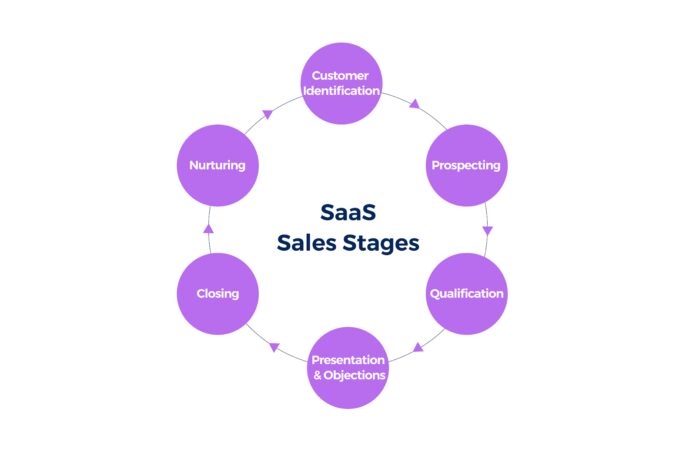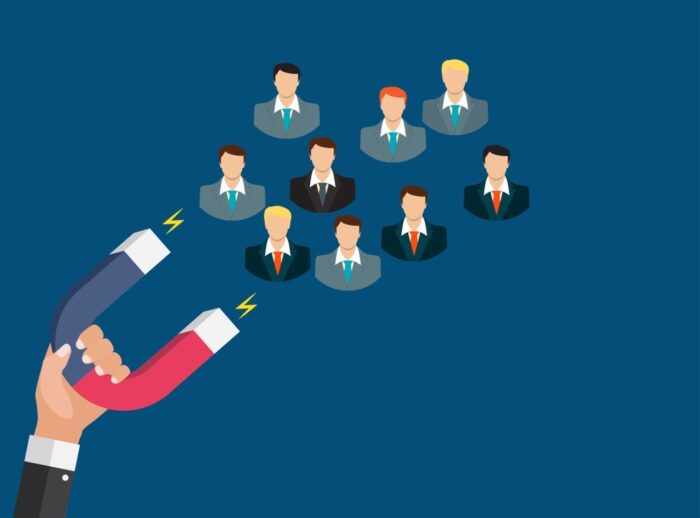
Here are the 7 essential stages of the B2B SaaS sales process you should understand thoroughly and strategize well to boost your sales.
1. Prospecting
This is the first stage of the SaaS sales process where you identify the target market and develop strategies to reach your B2B audience.
You can use multiple channels like Google or LinkedIn Ads, content marketing, social media posts, and videos to gain visibility on your ideal B2B customer’s radar.
Right from your newsletter to your blog, ebooks, guides, webinars, and so on can be used to capture SaaS leads by getting them interested in your offerings.
As selling a SaaS requires a more substantial education than tangible products, your SaaS salesperson should be trained to use these resources wisely.
2. Make Contact
Once you have identified your ideal B2B customers and created the resources to educate them, the next step is to connect with them.
How would you like to get in touch with your potential buyers?
Refer to the customer personas you have created to identify the best methods to contact your prospects. It could be sending cold emails or reaching out to them on LinkedIn and other social media channels. Some prospects may respond well to phone calls too.
When you are contacting these B2B representatives, remember your aim is not to make sales. Your focus should be addressing their pain points and educating them about your SaaS product.
3. Qualifying

Your marketing strategy will draw many visitors to your website. Many of them might even subscribe for a free trial of your B2B subscription billing solution.
The next stage in the sales process is to identify the most promising visitors and qualify them as leads.
How do you qualify the leads?
By collecting more information about the prospects and scoring them on the likelihood of contributing to your sales. Your sales reps can even contact the leads personally and understand their buying intentions. This stage is crucial as it can help you avoid wasting your time and resources on less interested visitors.
4. Presenting a Demo
Once you have shortlisted the most promising B2B SaaS leads, it’s time to present your SaaS as the most suitable solution to address their pain points.
You should spend some time figuring out the best demo techniques and presentation skills to impress your potential buyers.
One of the best techniques is to offer a free trial on your SaaS right at the outset. When you allow the leads to use the tools and discover their benefits, you are increasing their chances of converting.
At times when you are presenting more expensive or complex SaaS products to your B2B customers, you might have to create high-quality demo content to drive home the value of your offering.
Your product may have several useful features but you should be careful not to overwhelm your prospect by talking about all of them during a demo.
Customize your demo content for each client by focusing on the features that are relevant to them and impress them.
5. Handling Concerns and Objections

Once you have given a successful demo to your prospects, they will certainly have a list of concerns and objections. Addressing these concerns need not be a lengthy back-and-forth interaction.
Instead, you can take some time to listen to all the concerns and objections and address them in an effective question-and-answer session.
Let’s say, the stakeholders are not convinced about your live video shopping platform’s ROI. You can use case studies and data derived from your existing customers as proof to convince them.
6. Negotiating and Closing the Deal
When your prospect is convinced of your SaaS product’s benefits and is nearly ready to buy, you reach the negotiation stage.
Here the client would like to get your top services at the best price. For B2B prospects who might be comparing you with your competitors just on the price point, you can go ahead and offer a discount they can not resist.
As this client will be generating substantial revenue for you for a lengthy period, you can win their loyalty by offering free services or one month’s free usage in exchange for an annual fee.
7. Onboarding and Nurturing

Successful onboarding is a crucial stage of any B2B SaaS sales process. Provide them with expert support as they integrate your SaaS solution into their workflow and begin using it. Also, leverage the best sales CRM tool like Copper CRM to automate your sales process.
You should build a relationship with your clients based on trust and care. Periodically, take their feedback and measure their satisfaction. Personalizing your retention approach can help you reduce customer churn to a great extent.
Closing Thoughts
To create a successful B2B SaaS sales process, it is essential to plan each stage strategically. The outline provided above can be quite helpful in your planning.
Go ahead and utilize your resources smartly to win clients who can generate higher revenue for a longer period of time.
















